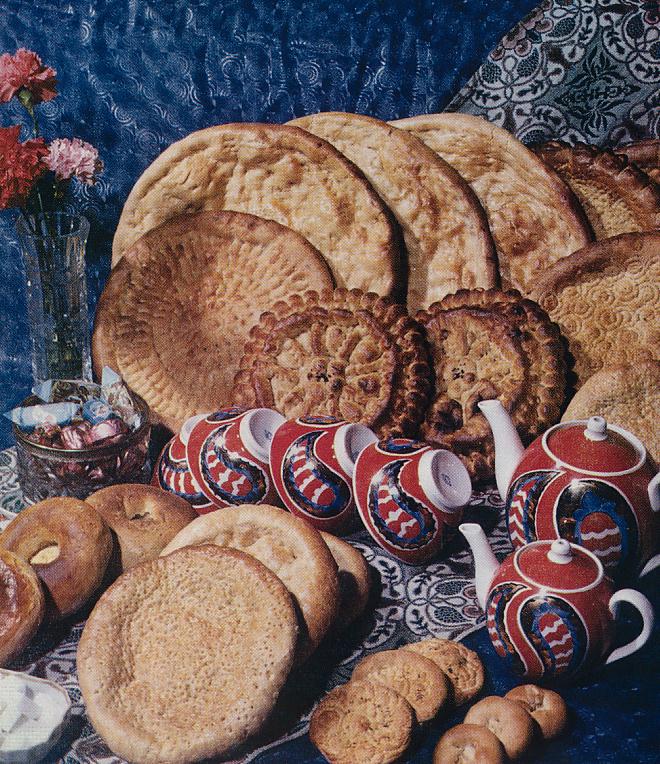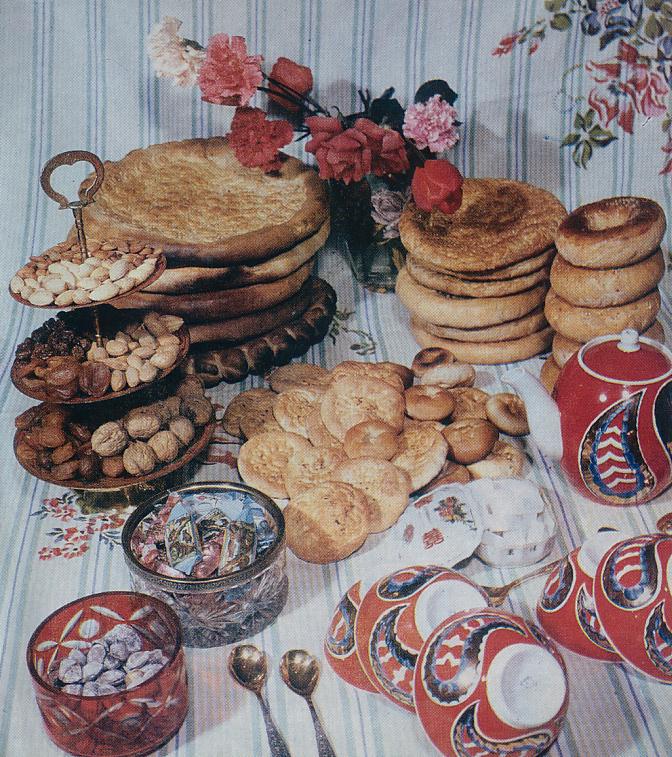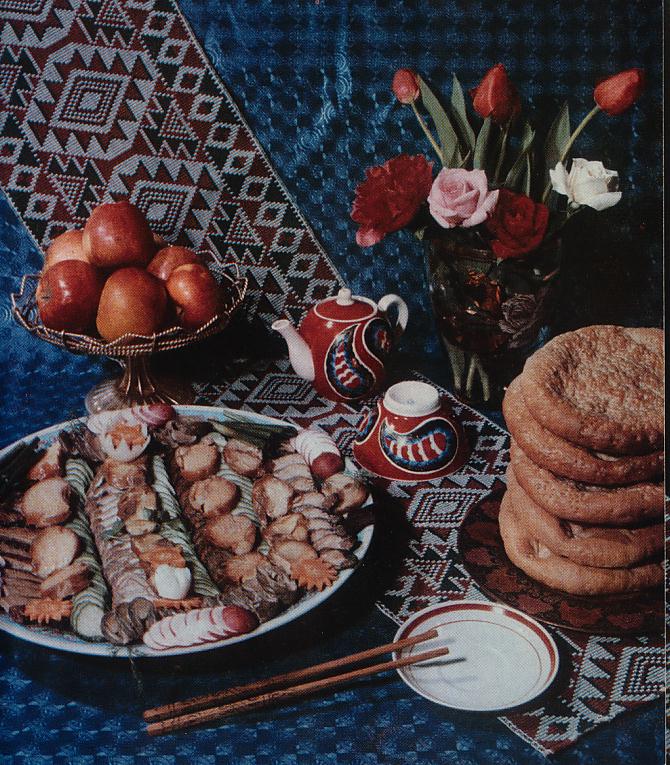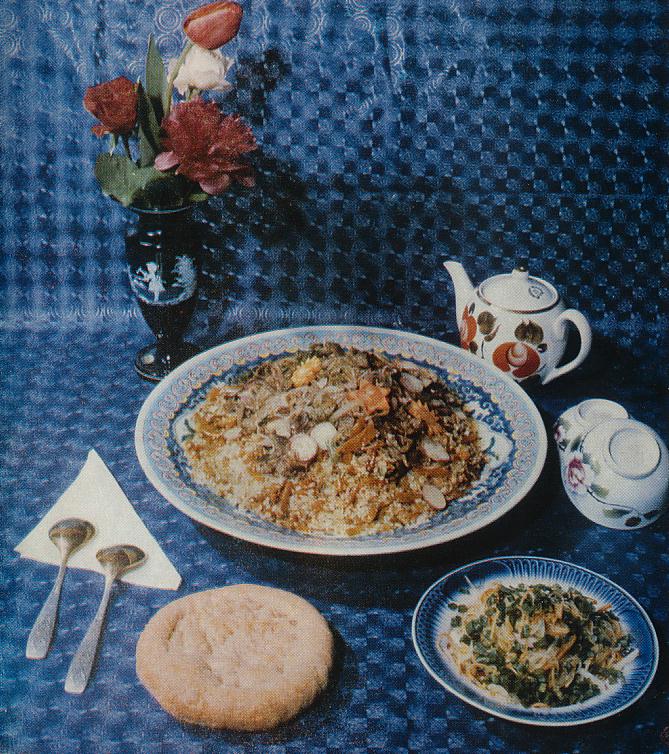Uyghur Cuisine
(Click on Thumbnails for high resolution Images. NOTE: Some high res. images may be several MB!)
Photo Courtesy: The Uyghurs

Photo Courtesy: The Uyghurs

Photo Courtesy: The Uyghurs

Photo Courtesy: The Uyghurs
Uighur cuisine synthesises influences of the west and east, antiquity and the present, great skill, imagination, beauty and harmony of taste. The Uyghur Region of P.R.C has the highest longevity rate in China. 25% of its population lives over a hundred years. In October,1985, the area was listed as The World Longevity Area by the International Natural Medical Science Commitee in Tokyo, Japan. The reasons for the high longevity in the area seem to be related to the region's weather, environment, and people's life habits and physical quality. Yet it is also directly because of their cuisine. Uighur food is characterized by meat - mutton, beef, camel, chicken, goose; vegetables - carrots, tomatoes, onions, peppers, eggplants, celeries etc.; dairy foods; and various fruits. Some popular Uighur dishes are briefly described below:
Cold dishes:
These can be divided into two kinds: dishes of various raw vegetables and cold dishes of boiled and fried vegetables. Raw vegetables (radish, tomatoes, cucumbers, pepper, string bean, bean sprouts, radish, cabbage, carrots, etc.) are ingredients of cold salads dressed with vinegar, hot oil, pepper and various spices. "Salads" with boiled and fried vegetables also contain meat, rice starch, and eggs. Gül’ Tavaq” - a flower dish - occupies a special place among cold dishes. This dish is a mix prepared from various vegetables, meat, and spices. Even though ingredients readily available determine variety of kinds of this dish, it is always a good-looking dish of chopped vegetables, fried and boiled and chopped meat. As a whole, the dish looks as a flower that consists of multi-colored petals.
First course dishes:
The Uighurs call these dishes meal of the tired, or meal of rest. Such soups are seasoned with fresh herbs or roots. Dough for soups can be prepared from different kinds of flour - barley, rice, wheat, and corn and almost has no analogies in other ethnic peoples’ cuisine. A Tripod site, "The Uyghurs", describes soup varieties in greater detail. Popular soups are:
Shova: various broths and soups with rice and vegetables; and
Süyuqash: soups with noodles, and broth or fried sauce.
Längmän is the most favorite and popular dish of the Uighur cuisine. It includes long noodles prm.htepared from thin strings of dough stretched from thick wisps served with a sauce. Every Uighur meal has its symbolism. This meal is referred to as a dish of love. Love should last long as the noodles are. The Uighurs prepare four kinds of längmän sauce depending on seasons: In spring, the sauce is prepared from spring onions, jusäy sprouts, celery and radish; In summer, cucumbers, garlic sprouts, usun, short and long kidney bean, tomatoes, green & red pepper, eggplants, garlic, onions and spring onions are added to the sauce; In autumn, the sauce includes carrots, kohlrabi, and radish; In winter, the sauce is prepared from dried and pickled vegetables. Also, there are different kinds of längmän, which differ by way of cooking, thickness of noodles, kind of a flour, etc. In Kashgar, längmän is nicknamed "snakes".
Manty (Dimsum like dish)[1], [2] is an dish whose symbolism relates to a dish of the dzhigits (brave men). Manty are cooked on steam in a special cookware, which consists of sieves inserted one into another and called qasqan, or a flat vessel, weaved from cane - jimbil. Manty, as well as ravioli - chö & ürä, are prepared from rolled out dough with a stuffing. The dish could be prepared in a variety of ways, with different kind of dough and ingredients of a stuffing. Dough used for manty could be both leavened and unleavened. The stuffing also could vary including gourd (squash), meat, onions, jüsäy, fig, clover, spring onions, quince, vegetables, etc.
Polo: The Uighurs frequently cook polo - pilaf. In general, this dish is the meal of guests. For a plenty of people, polo is cooked by a þpäz, specially invited cook who takes care of preparing polo on weddings or commemoration services. Cooking polo requires deft skills. Ingredients are rice, meat, carrots and onions. Pretty often polo is dressed with garlic or raisins.
Samsa[1], [2] is one of the most honoured ancient Uighur dishes. It is a patty filled with ground meat and onions, gourd (sqyash), vegetables and fruits. Samsa is cooked in a tono, a cone-shaped oven for baking bread or in a cauldron. Dough for samsa is kneaded depending on where it would be cooked. For example, for tono samsa, the dough has to be kneaded, and is salty and stiff; for samsa cooked in a cauldron, the dough could be flabby and yeasty.
Pörä: A kind of fried meat pie, filled with herbs, jüsäy, clover, wheat sprouts, dill, cabbage, and coriander. The filling could be the chopped meat and onions.
Göþ nan Bread patties filled with meat and onions, baked in a cauldron.
Olouh nan Steam bread roll prepared with carrots, gourd, jüsäy, spring onions, etc.
Breads[1], [2]: The Uighurs make bread from wheat flour, sometimes, from corn flour. Bread is usually baked in tono big ovens, from leavened or yeasty dough in form of a pita: large and thin çong nan, small and thick - toðaç. The Uighurs bake short puff pitas in a cauldron - qatlima from dough made on oil and cream as well as thin pancakes - po qal. On holidays people make various short pastries in a cauldron, in particular, sangza. Bread baked in tono is considered the most nutritious, because it absorbs the heat of the fire. There are more than 40 (forty) ways of making bread in Uighur cuisine.
Tea occupies an important place in a diet of the Uighurs. Since the Silk Road passed through Uighur territories, tea has been known to them for considerable period of time. The Uighurs make tea in different ways and have their own tea rituals.
References:
The Uyghurs - Tripod siteUyghur Cuisine - Uygur World
Amina Abdurahman, Western Illinois University
Please e-mail Ravi Kanda if you have any suggestions, comments or corrections.